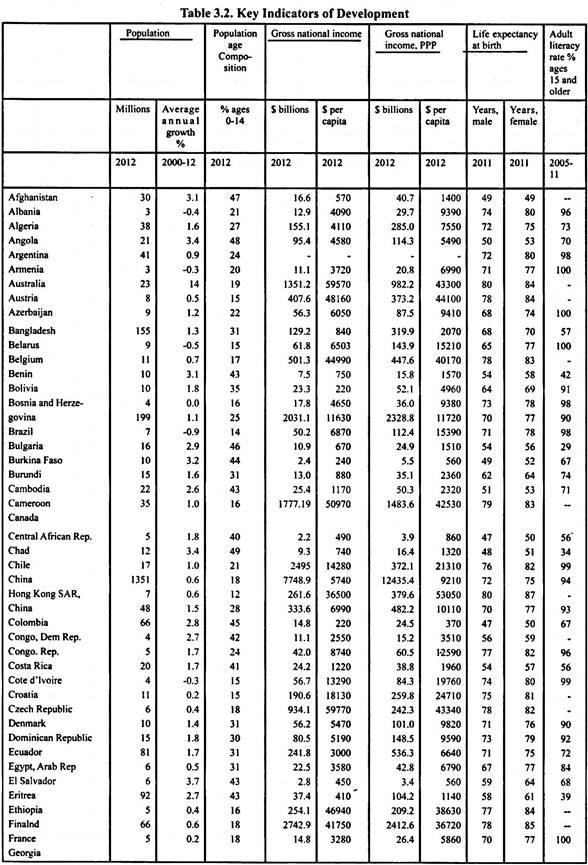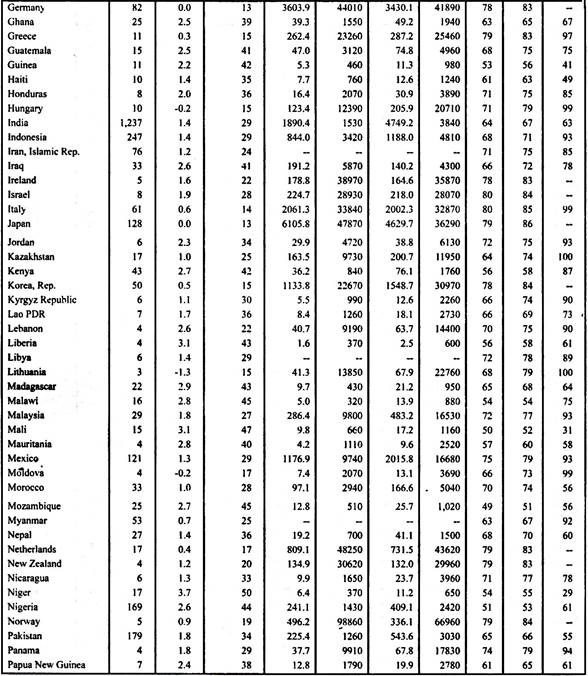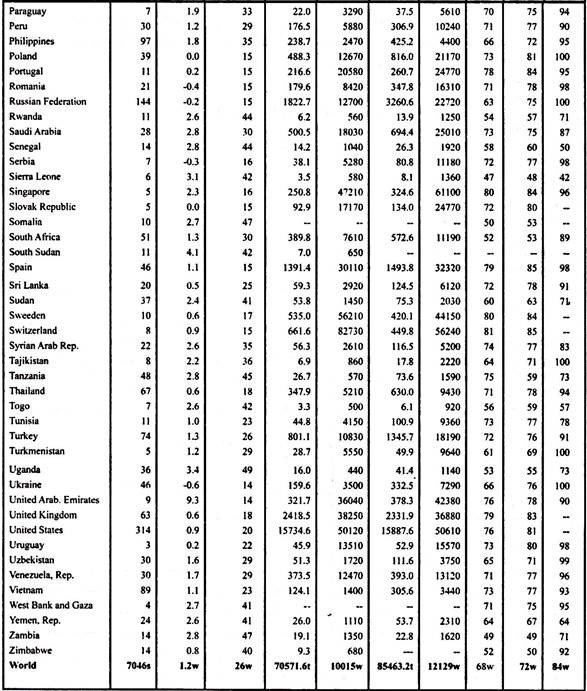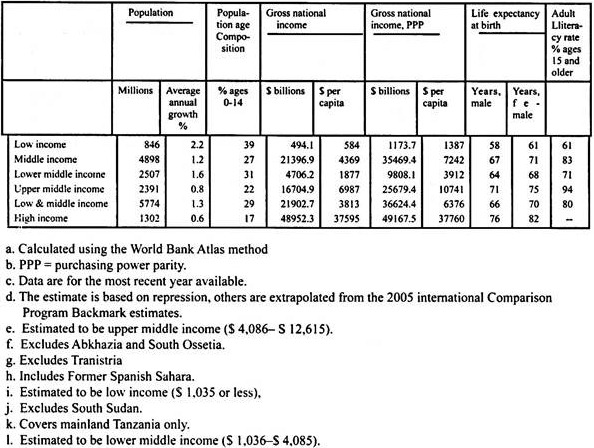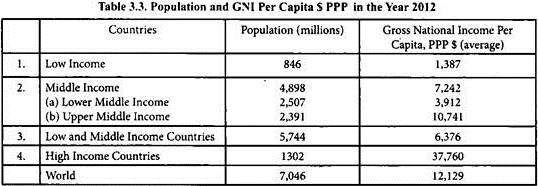Despite shortcomings of per capita income as a measure of development, the World Bank, International Monetary Fund (IMF) and other international agencies consider developed and developing countries in terms of Gross National Income (GNI) per capita. The World Bank classifies different countries of the world on the basis GNI per capita representing their development status. The figures of GNI per capita of different countries used belong to the World Bank fiscal year ending on June 30 of the year.
According to this World Bank classification:
(i) low income countries are those with GNI per capita of $ 1035 or less in 2012 (the latest year which is presently available).
(ii) Middle income countries are those with GNI per capita more than $ 1035 but less than $ 12,616.
ADVERTISEMENTS:
Middle income countries are further divided into:
(a) Lower middle income economies and
(b) Upper middle income economies.
(iii) High income economies which have GNI per capita of $ 12, 616 or more.
Table 3.1 gives classifications of economies by region and per capita income (i.e., GNI per capita). Table 3.2 gives GNI per capita and other key indicators of development such as population and its growth rate, life expectancy at birth and adult literacy rate. 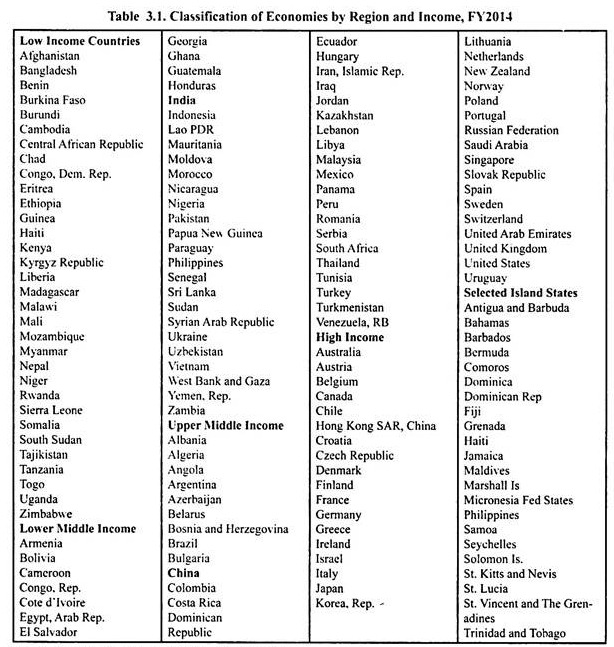
It is important to note that developing countries are those whose GNI per capita falls in low income and middle income range. Low-income countries have less than $ 1035 GNI per capita and middle income countries have per capital income more than $ 1035 but less than $ 1266 based on their official or current exchange rates of the national currencies into US dollars.
It will be seen from Table 3.2 that in 2012, India with per capita income of $ 1530 at current exchange rate falls in lower middle income category while China with $ 574 per capita income at the current exchange rate falls in the upper middle income countries. However, as explained above, both India and China are described as developing countries.
On the other hand, U.S. with per capita income of $ 5012, U.K. with per capita income of $ 38250, Germany with a per capita income of $ 44010 and France with per capita income of $ 41750 in 2012 is high-income countries and is described as developed economies.
It may be noted that the terms ‘developing’ and ‘developed’ are used for convenience. It is not intended to imply that all economies in the group of developing countries are experiencing similar developments. Likewise, for describing some countries as ‘developed’ is not meant that they have reached a preferred or final stage of development.
ADVERTISEMENTS:
In fact, they too are growing and developing further. Further, classifying different countries according to the size of their per capita income does not reflect their permanent development status. A country’s per capita may rise with time as development proceeds further and therefore its development status may shift from low income to middle income or middle income to high income category.
The Development Gap and Income Distribution in the World Economy:
An important feature of world economy is that world’s income is distribution extremely unequally between different countries and people. We have referred above to North-South divide which means there are wide differences of per capita income an indicator of development between rich industrialised countries mainly located in the northern hemisphere on the one hand on semi-industrialised development countries mainly situated in the southern hemisphere.
The division in the global economy is also often made between the developed continents of Europe and North America on the one hand and poor and developing continents of Asia, Africa and Latin America on the other. It is however important to note that, developing countries of Asia, Africa and Latin America are not completely homogeneous though they have many common characteristics and impediments to development. It is often said that there is a good deal of commonality among diversity among the developing nations.
One significant aspect of the differences among the poor and developing countries is with to regard to economic growth and development achieved by them since 1960s. While in the race of economic development South East Africa, China, India has forged ahead, the countries of Africa have left behind, and Latin America occupies a middle position with respect to its development performance.
As explained above, the World Bank in its annual World Development Report classifies different 188 countries of the world into:
ADVERTISEMENTS:
(1) Low income countries (LIC),
(2) Middle income countries (MIC) and
(3) High income countries (HIC).
ADVERTISEMENTS:
The middle income countries are further divided into:
(a) Lower middle income countries and
(b) Upper Middle Income Countries.
Table 3.3 among other things, gives the level of per capita national income measured in PPP 2012 (column 7) in different countries of the world. It will be seen from this table that in terms of per capita income ($ PPP 2012) with $ 370 $ PPP 2012, Democratic Republic of Congo is the poorest country and with GNI per capita Norway $ 66960 is the richest country of the world. In Table 3.3 average levels of per capita national income are given separately for low, middle and high income countries of the world.
ADVERTISEMENTS:
Table 3.3 reveals that, a large development gap exists between low income countries (with $ 1,035 PPP or less) and high income developed countries (with $ 12,615 PPP or above) in 2012.
In low income countries containing 846 million population average per capita income of $ 1,387 PPP as against average per capita income of $ 37,760 PPP of high income countries having population of 1,302 million in 2012. This is indeed a very large development gap between the low income countries and high income countries. Developing countries as generally defined contain both low-income and middle-income countries. It will be interesting to compare the gap between the developing countries as a whole on the one side and high income developed countries.
It will be seen from Table 3.3 that developing countries (i.e. low and middle-income countries) containing 5.74 billion population have average per capita income equal to $ 6,376 PPP in 2012 as against average per capita income of $ 37,760 PPP of high-income developed countries having total population of 1.30 billion in 2012. This too is a very large income gap which has to be bridged by developing countries by achieving a much higher rate of GDP growth than that of developed countries, if they desire to catch up with them. China and India, the two fastest growing countries of the world, are expected to catch up with the developed countries by 2050.
